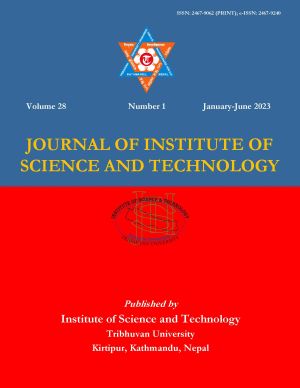Hydrochemistry of Kupinde Lake at the Lesser Himalaya in Karnali Province, Nepal
DOI:
https://doi.org/10.3126/jist.v28i1.49052Keywords:
Hydrochemical facies, hydrochemistry, multivariate analysis, irrigation parameters, water qualityAbstract
Hydrochemical assessment of the freshwater lakes provides important insights into the sources of dissolved ions, geochemical processes, and anthropogenic activities taking place in the environment. This study focuses on the assessment of hydrochemistry and water quality of Kupinde Lake, Karnali Province, Nepal. Surface water samples were collected from 24 different locations of the lake in October 2021 and analyzed for 18 different physico-chemical parameters. The pH, temperature, electrical conductivity and total dissolved solids were measured on-site, and concentration of major ions (Ca2+, Mg2+, Na+, K+, NH4+, HCO3-, Cl-, SO42-, PO43-, NO3-), including hardness and free CO2 were measured in the laboratory. The results revealed that lake water was alkaline with abundance of the major ions in the following order: Ca2+ > Mg2+ > Na+> K+ > NH4+ and HCO3- > Cl- > SO42- > PO43- > NO3- for the cations and anions, respectively. The lake water was dominated by Ca-HCO3, indicating calcium carbonate dominated lithology in the area. Gibb’s plot and Piper diagram illustrated rock weathering as the most dominant process in controlling the hydrochemistry of the lake basin. The suitability of water for drinking and irrigation was determined using geochemical indices and WHO standards. The results indicated that the Kupinde Lake water could be used for drinking and irrigation purposes in terms of measured hydrochemical variables.
Downloads
Downloads
Published
How to Cite
Issue
Section
License
Copyright (c) 2023 Institute of Science and Technology, T.U.

This work is licensed under a Creative Commons Attribution-ShareAlike 4.0 International License.
The views and interpretations in this journal are those of the author(s). They are not attributable to the Institute of Science and Technology, T.U. and do not imply the expression of any opinion concerning the legal status of any country, territory, city, area of its authorities, or concerning the delimitation of its frontiers of boundaries.
The copyright of the articles is held by the Institute of Science and Technology, T.U.




